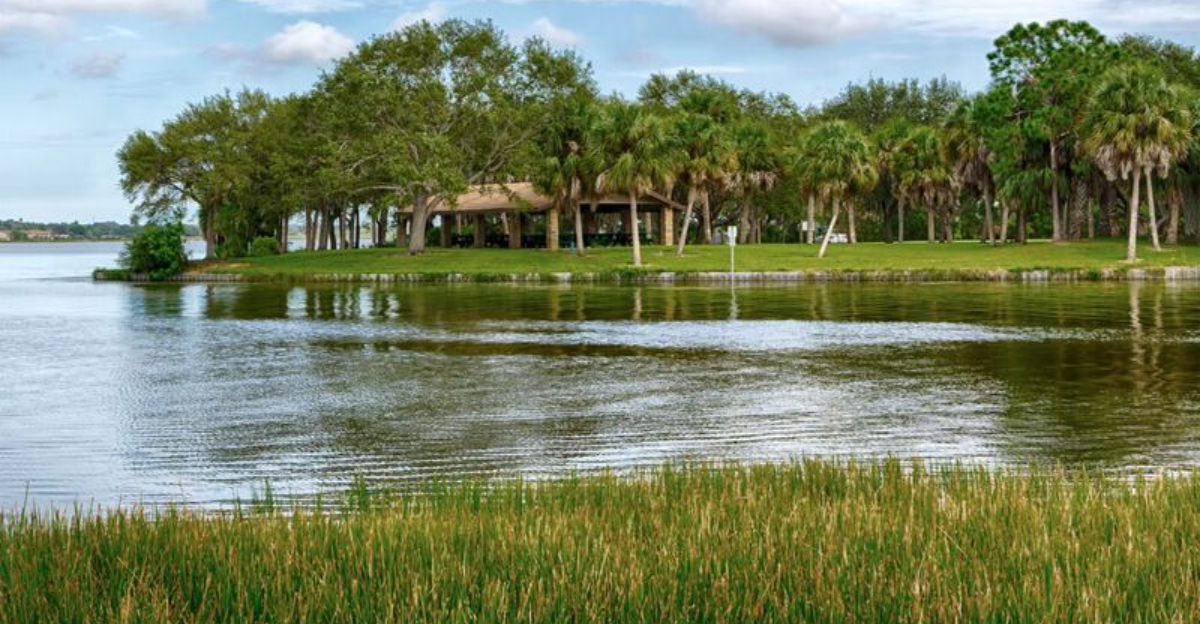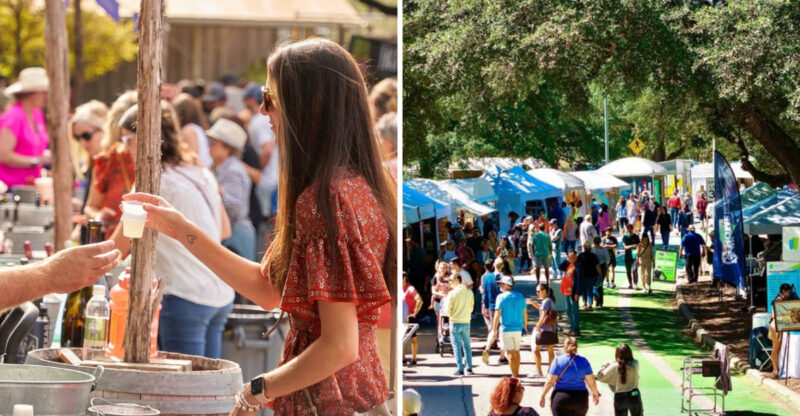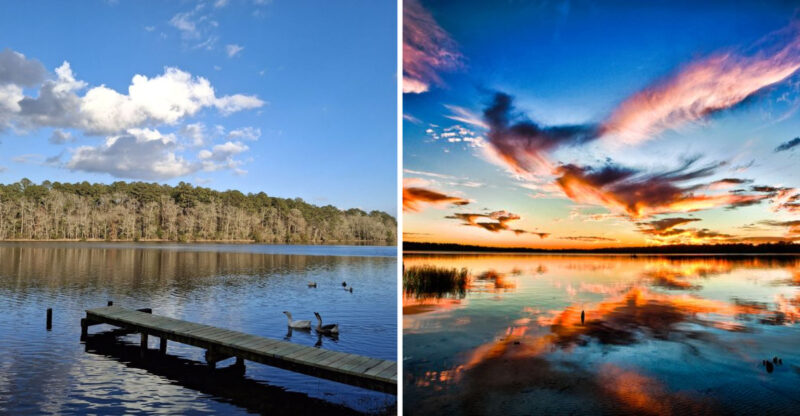A Freshwater Paradise On The Florida-Georgia Line With World Class Fishing

Straddling the border where Florida meets Georgia, Lake Seminole has earned a reputation among anglers as one of the Southeast’s premier fishing destinations.
This sprawling reservoir offers crystal-clear waters, abundant fish populations, and a tranquil setting that draws outdoor enthusiasts year-round. Whether casting for trophy bass or simply soaking in the natural beauty, visitors discover why this freshwater gem continues to captivate hearts.
1. Location And Lake Overview
Formed in 1957 by the Jim Woodruff Dam, Lake Seminole spans roughly 37,500 acres where the Chattahoochee and Flint Rivers converge. The reservoir sits at the two-state junction of Florida and Georgia, creating a unique geographic landmark.
Shallow flats, winding river channels, and countless coves define the landscape. This diverse terrain supports thriving ecosystems and provides anglers with endless exploration opportunities throughout the sprawling waterway.
2. Hydrology And Water Clarity Patterns
Water levels fluctuate based on rainfall and dam releases from upstream reservoirs, influencing clarity and fishing conditions. During stable periods, visibility can extend several feet, allowing anglers to spot structure and vegetation below.
Spring rains sometimes stain the water with tannins from surrounding wetlands. Even with color variations, the lake maintains excellent habitat quality, supporting healthy fish populations and abundant aquatic plant growth year-round.
3. Target Species Largemouth Bass Crappie And Catfish
Largemouth bass dominate the angling scene, with specimens regularly exceeding eight pounds and occasional trophies topping double digits. Crappie fishing peaks during spring spawns, when slabs gather near brush piles and submerged timber.
Channel catfish and flatheads cruise deeper channels and creek bends. Anglers targeting cats find consistent action using cut bait and live offerings, especially during warmer months when these bottom feeders become more active.
4. Seasonal Bite Windows And Best Months
Spring brings explosive action as bass move shallow to spawn, typically peaking from March through May. Water temperatures climb into the mid-sixties, triggering aggressive feeding patterns that reward anglers with memorable catches.
Fall offers another prime window when cooling water pushes baitfish into the shallows and predators follow. Winter fishing remains productive for those willing to slow down presentations and target deeper structure during colder stretches.
5. Habitat Highlights Hydrilla Standing Timber And Flats
Hydrilla beds blanket vast sections of the lake, creating dense cover where bass ambush prey and crappie suspend near edges. Standing timber from the original flooded forest still punctuates many areas, offering vertical structure that attracts fish.
Expansive grass flats stretch across the upper reaches, providing ideal habitat for spawning and feeding. Navigating these varied zones requires careful attention, but rewards boaters with access to some of the lake’s most productive fishing grounds.
6. Productive Techniques And Tackle Recommendations
Flipping and pitching soft plastics into heavy cover produces consistent bass strikes, especially around timber and vegetation edges. Topwater lures generate explosive action during low-light periods when fish cruise the shallows hunting for meals.
Crankbaits worked along drop-offs and channel swings trigger reaction bites from aggressive bass. Crappie anglers find success with small jigs and live minnows suspended beneath slip bobbers, adjusting depth until locating suspended schools near structure.
7. Shoreline Access Boat Ramps And Marinas
Multiple public boat ramps ring the lake, providing convenient access points for anglers and recreational boaters. Facilities on both the Florida and Georgia sides offer parking, restrooms, and courtesy docks for safe launching and loading.
Full-service marinas supply fuel, tackle, and boat rentals for visitors without their own watercraft. Some locations also feature fish cleaning stations and covered slips, making extended stays more comfortable for serious anglers planning multi-day trips.
8. Guides Outfitters And Local Bait Shops
Experienced guides operate throughout the lake, sharing local knowledge and proven techniques that help visitors maximize their time on the water. Half-day and full-day trips cater to all skill levels, from beginners to seasoned tournament anglers.
Bait shops stock live minnows, shiners, and nightcrawlers alongside a full selection of lures and terminal tackle. Staff members often provide up-to-date fishing reports and tips on current hot spots, helping newcomers get oriented quickly.
9. Regulations Licenses And Interstate Boundary Notes
The lake straddles state lines, but anglers only need either Florida or Georgia fishing licenses. Regulations regarding size limits, bag limits, and season dates can vary between states, so checking current rules before heading out is essential.
The two-state boundary adds a layer of complexity, but most marinas and bait shops provide updated information. Respecting posted regulations helps preserve the fishery for future generations while ensuring a hassle-free experience on the water.
10. Lodging Camping And RV Options
Campgrounds around the lake offer sites for tents, RVs, and travel trailers, many with electric hookups and water access. Waterfront spots allow campers to launch boats steps from their campsites, creating a seamless outdoor experience.
Nearby towns provide hotels and vacation rentals for those preferring indoor accommodations. Cabin rentals with screened porches and lake views blend comfort with proximity to fishing, appealing to families and groups seeking a home-away-from-home atmosphere during their stay.
11. Family Activities, Birding, Paddling And Scenic Stops
Beyond fishing, the lake attracts birdwatchers hoping to spot herons, ospreys, and bald eagles gliding above the water. Paddlers explore quiet coves and narrow tributaries where powerboats rarely venture, discovering hidden corners teeming with wildlife.
Picnic areas and swimming beaches provide spaces for families to relax between fishing sessions. Scenic overlooks along shoreline roads offer photo opportunities, capturing sunsets that paint the water in shades of orange and pink across the horizon.
12. Safety Considerations Weather Navigation And Wildlife
Afternoon thunderstorms develop quickly during summer months, so monitoring weather forecasts and heading to shore at the first sign of lightning is crucial. Shallow areas and submerged stumps require careful navigation, especially for boaters unfamiliar with the lake’s layout.
Alligators inhabit the lake, so keeping a respectful distance and never feeding wildlife ensures safe encounters. Wearing life jackets, carrying communication devices, and informing someone of your plans are simple steps that enhance safety on every outing.






